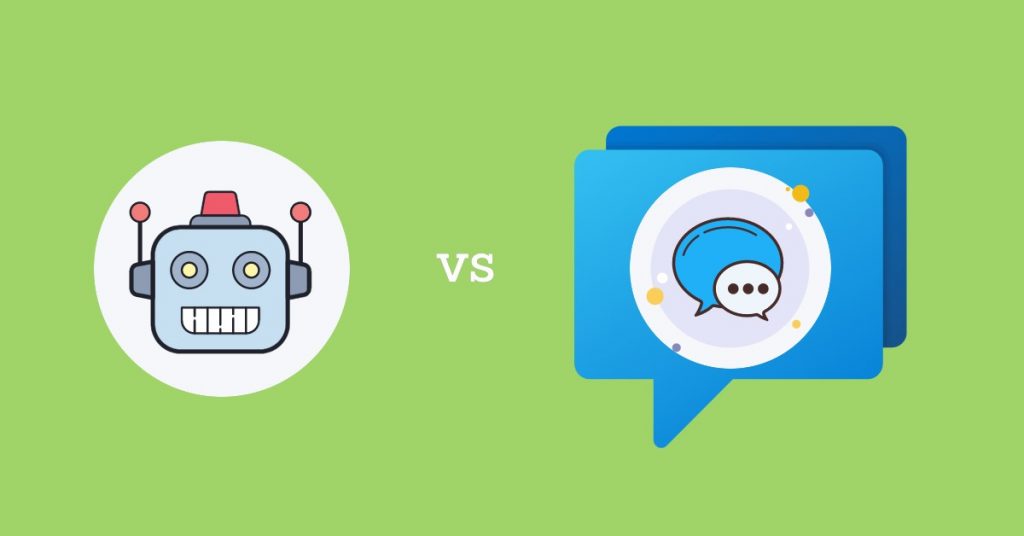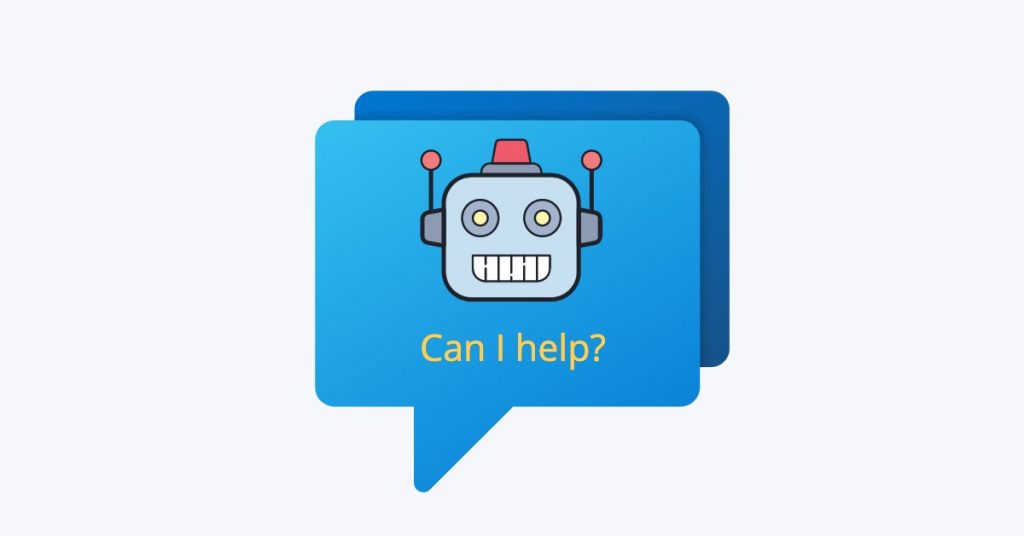The use of chatbots has been steadily on the rise, but how do they hold up against live chat support?
While both are designed to enhance how you connect with customers, each tool offers distinct advantages tailored to different business needs.
Statistics show that at least 79% of businesses consider automation to be essential for their customer experience strategy.
Why? Because customers really value instant responses. They simply don’t have the patience to wait for an email or stay on the line until their inquiry gets resolved.
In fact, 71% of consumers feel that immediate assistance can drastically improve customer satisfaction.
So incorporating chat support is non-negotiable for any business in 2024.
Before deciding which tool – chatbot vs live chat – aligns best with your business objectives, it’s crucial to understand their specific advantages.
Let’s explore these differences further.
What is Live Chat?
Live chat is a real-time communication tool that allows businesses to interact directly with customers through their media properties including websites, apps, and even social media channels.
This is normally embedded as a chat widget that enables website visitors to initiate a conversation with support agents at any moment during their browsing experience.
Ultimately, live chat aims to mimic the personal touch of face-to-face interactions but in a digital environment, offering a convenient and efficient service option to boost customer satisfaction.
Find out more about the benefits of using live chat for customer support here.
What is a Chatbot?
Chatbots are designed to offer real-time customer support, much like live chats, but without human agents.
They can range from simple software systems that provide limited responses to complex AI-driven bots that learn and evolve from interactions.
Whether a chatbot uses pre-set scripts or artificial intelligence, its purpose is to provide quick, automated responses to common customer inquiries or tasks.
This allows businesses to offer round-the-clock customer service, streamline interactions, and handle high volumes of requests simultaneously, without human intervention.
Learn how chatbots can improve customer experience here.
Chatbot vs Live Chat: What’s The Difference?
Ease of use
Live chat
Live chat typically requires well-trained customer support agents. Once your live chat software is installed, the human agents can immediately start interacting with website visitors.
For instant responses, provide your team with access to a knowledge base, customer data, and Frequently Asked Questions (FAQs). This will ensure that they have everything at hand when dealing with customer queries.
Chatbots
Chatbots aren’t as straightforward to implement as human interactions. Setting them up requires careful planning and development. Even with advanced AI technology, creating an effective chatbot often involves constructing it from the ground up.
To go beyond basic greeting messages, you must develop a dialogue flow tailored to specific conversational goals.
This process includes several critical steps:
- Defining the bot’s purpose: Determine what each conversation with the bot should achieve, considering the intent and context. This often requires extensive research to align with user expectations accurately.
- Designing the conversation flow: Utilize a chatbot editor to map out the interaction sequences. It’s crucial to recognize that customers may phrase the same queries in various ways. Your design should accommodate these variations to ensure the bot understands and responds appropriately.
- Testing the chatbot: Rigorously test the chatbot in different scenarios to ensure it handles inquiries as expected and navigates the conversation flow smoothly.
- Training the bot (Optional): Depending on the desired complexity, you might need to train the bot further to refine its responses and decision-making capabilities.
While this process doesn’t necessarily require coding skills, it’s far from simple and can be quite time-consuming!
Sounds hard? It doesn’t need to be. With Social Intents, you can set up a chatbot in just a few minutes. No technical skills needed. Learn more here.
Availability
Live chat
Live chat requires a support team of human agents. This means that offering live support 24/7 is often costly and unrealistic for many businesses.
Even with the resources to do so, maintaining continuous human-operated service can be difficult.
Plus, if your business operates on an international scale, accommodating time zone differences can be tricky when you only offer live chat support during business hours.
Chatbots
Chatbots provide immediate support and can handle multiple conversations simultaneously. This keeps your business responsive to customer inquiries even during off-hours.
They handle routine questions efficiently, and if faced with complex issues, they can advise customers to return during business hours or provide alternative contact methods.
This is great for capturing leads at any time.

Response time
Live Chat
Live chat response time is generally longer, as it depends on the availability of human agents who can only manage support tickets at a time.
Live chat agents need time to read a customer query, look up information, and type out a response, which can introduce delays. This is especially a problem during peak times when customers are more likely to become frustrated.
Chatbots
Chatbots are designed to provide instant answers, typically within 1-5 seconds of a customer’s question. This response rate is possible because they operate on pre-programmed responses triggered by specific keywords.
They also don’t require breaks or shift changes and can handle multiple queries simultaneously, which is particularly advantageous during periods of high demand. This capacity to deliver quick answers to common questions effectively reduces wait times.
Query handling
Live Chat
Live chat offers the advantage of human touch. Support agents can perceive and adapt to subtle cues in a customer’s text, such as tone and context, which a chatbot might miss.
This capability allows live chat operators to handle complex emotional states and specific customer interactions more effectively than chatbots.
Chatbots
Chatbots can be limited by the scripts and programming they follow. Standard chatbots operate based on predetermined responses to trigger words, making them highly efficient at handling frequently asked questions, welcoming users, and managing data-centric inquiries.
However, they need help detecting sarcasm, interpreting emotional undertones, and managing spelling errors, which can lead to misunderstandings or unsatisfactory customer interactions.
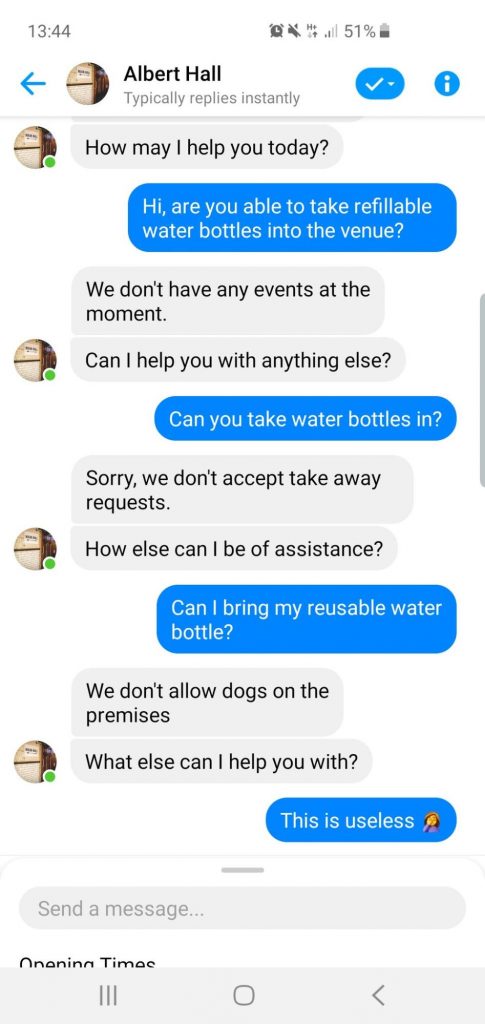
Multilingual chats can cause further inaccuracies by misinterpreting or oversimplifying expressions. Opting for AI chatbot technology can minimize these difficulties.
Due to their natural language processing ability, these bots can learn from past interactions, gradually improving their ability to handle more complex conversations and better mimic human conversational styles.
Cost-effectiveness
Live Chat
Live chat requires a support team that needs to be paid for their work. Thus, the cost-effectiveness of this tool depends on the volume of interactions and the operational hours required to manage it.
Live agents can only handle a few customer inquiries at a time, making this option less scalable. Training and maintaining a skilled live chat team also adds to the customer service costs.
However, for businesses that deal with complex customer service issues requiring human judgment and empathy, the investment in live chat can increase customer satisfaction and loyalty. This can lead to higher customer lifetime value.
Chatbots
Chatbots are generally more cost-effective due to their scalability and automation capabilities. Once developed, a chatbot can handle countless interactions simultaneously without incurring additional costs per conversation.
This scalability makes chatbots particularly effective for businesses experiencing high volumes of customer inquiries, as they can manage these without the need for proportional increases in staffing.
Overall, they significantly reduce the labor costs associated with staffing a customer service team around the clock.
Customer engagement
Live Chat
Live chat software brings with it the benefit of human touch.
Statistics show that 86% of customers still prefer to interact with customer service reps, and 71% are less likely to use a brand if it doesn’t have human customer service agents available.
Given that consumers still value human interaction, implementing live chat solutions will enhance customer satisfaction.
Chatbots
Chatbots have the highest satisfaction level in delivering fast responses and providing uninterrupted 24/7 support.
Their capabilities ensure that customers receive immediate attention and relevant prompts. This can enhance customer experience on your website and prevent potential drop-offs in scenarios like e-commerce transactions.
Ultimately, the automated nature of chatbots makes them highly efficient at managing routine tasks and responses, facilitating a level of operational consistency and reliability that’s hard to achieve with human agents alone.
Personalization
Live Chat
Live support agents can provide personalized responses to fit the specific needs of each customer.
This makes live chat particularly effective in situations where empathy, understanding, and productized knowledge are crucial. This includes handling sensitive issues or providing detailed product recommendations.
Chatbot
Advanced chatbots powered by AI can learn from interactions to improve their responses over time, and they can handle a basic level of personalization.
Examples include addressing a customer by name or providing customized product suggestions based on browsing history.
However, chatbots still lack the ability to fully understand complex human emotions or unique situational contexts like a customer support team can.
Conversions
Live Chat
Data indicates that introducing a live chat feature can lead to an 8%-20% increase in conversions.
Customers engaging in live chat are nearly three times more likely to convert compared to those who don’t use the chat feature.
This high conversion rate is partly due to the ability of live chat agents to understand and react to customer needs in real-time.
Well-trained agents can offer tailored deals, effectively address objections, and even increase average order value through upselling techniques.
Their capacity to connect personally and adapt conversations makes them highly effective at converting browsers into buyers.
Chatbots
Figures show that 41.3% of consumers use chatbots during purchases across different communication channels.
Their ability to provide instant responses is a significant asset, especially on critical conversion points like pricing pages.
By answering common pricing queries quickly and efficiently, chatbots can reduce the friction typically associated with the decision-making process.
To put it simply, they act like personal shopping assistants by offering recommendations and reducing the time customers spend navigating through product pages.
This streamlined approach can improve the customer’s journey, making it more likely for them to proceed to checkout.
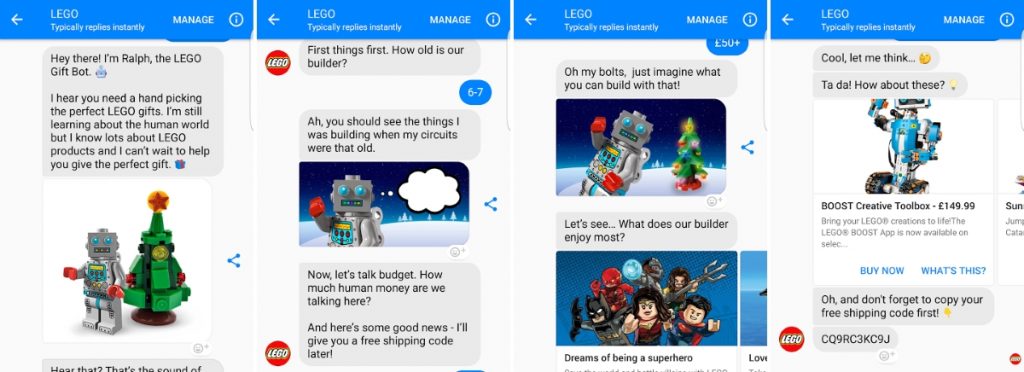
Lego’s bot ‘Ralph’ asks people a few questions and gives them perfect recommendations for faster conversions. From asking questions about age, and price category, to offering a free shipping code, ‘Ralph’ is making quite an impression.
When to Use Live Chat
Live chat messaging is particularly beneficial for:
- Small businesses: For start-ups and smaller companies with low to moderate customer interaction volumes, live chat is a cost-effective solution. This setup helps maintain a personal touch and high-quality service without requiring extensive resources.
- Businesses with domestic consumers: For businesses operating in a specific region or time zone, live chat provides an effective way to manage customer inquiries during business hours without the need for round-the-clock staffing.
- Businesses with complex products and services: Live chat enables businesses to deploy specialists who can offer immediate, expert recommendations.
When to Use a Chatbot
Chatbots are particularly advantageous for:
- Businesses with high volume inquiries: Chatbots can dramatically improve response times and overall efficiency.
- Businesses with a low budget: Chatbots handle routine inquiries efficiently, allowing these businesses to manage customer interactions even with a small team.
How to Use Live Chat and Chatbots Together
Chatbot vs live chat…why not just use both?
Instead of having to choose between a chatbot or chat operator, you can adopt a hybrid approach.
This means that you leverage the strengths of both tools, optimizing your customer engagement strategy to benefit consumers and live chat agents alike.
Let’s take a look at how they can be integrated:
Automate routine customer queries
Identify the most frequently asked questions (FAQs) and scenarios that can be fully automated.
Use these insights to train your chatbot, optimizing it to handle these issues with high accuracy. This frees up human agents to focus on more complex customer queries.
Transfer complex inquiries to human agents
Improve customer satisfaction by including an easy option for customers to escalate the conversation to live chat support if the chatbot can’t adequately address their concerns.
This transition should be smooth, ensuring that the customer does not have to repeat information.
TIP: Enhance this feature with an alert system that notifies agents immediately when their intervention is needed.
Improve chatbot with predictive analytics capabilities
Predictive analytics capabilities can help chatbots foresee customer needs before they even articulate them fully.
By analyzing past interactions and customer data, the chatbot can offer suggestions and solutions proactively, improving customer engagement.
When the system predicts that a query might require human empathy or complex problem-solving, it can seamlessly transfer the chat to live chat support.
Implement a hybrid live chat widget
A hybrid live chat widget initially engages users with a chatbot but then transitions the interaction to a live human agent. This setup ensures that customers receive instant responses to initial inquiries, which can enhance engagement and capture vital data.
Monitor your Key Performance Indicators (KPIs)
To ensure your customer service consistently meets customer expectations, it’s crucial to regularly monitor the progress of your support tools.
By gauging the effectiveness of your strategy, you can optimize accordingly and guide improvements where necessary.
This is particularly important when you integrate technologies like a live chat and chatbot into your customer service framework.
KPIs provide insights into customer engagement with these tools and indicate the types of refinements needed for your chatbot scripts and live chat processes.
Let’s take a look at some key metrics you should be tracking:
- First Response Time (FRT): Measures the time it takes for a chatbot or live agent to respond to a customer’s initial query. Quick responses are crucial for increasing customer engagement.
- Average Resolution Time (ART): Tracks the average time it takes to resolve a customer’s issue from start to finish. This helps in understanding the efficiency of the chat service.
- Customer Satisfaction Score (CSAT): This is usually collected through post-interaction surveys asking customers to rate their satisfaction with the chat service. It’s a direct measure of how well the chatbot or live chat is meeting customer needs.
- Conversion Rate: Particularly important for sales-driven chats, this measures how often conversations with a chatbot or live agent lead to a sale or desired outcome.
- Net Promoter Score (NPS): This metric gauges customer loyalty and the likelihood of customers recommending the service to others.
How to Use Social Intents to Install Chat Support In Minutes
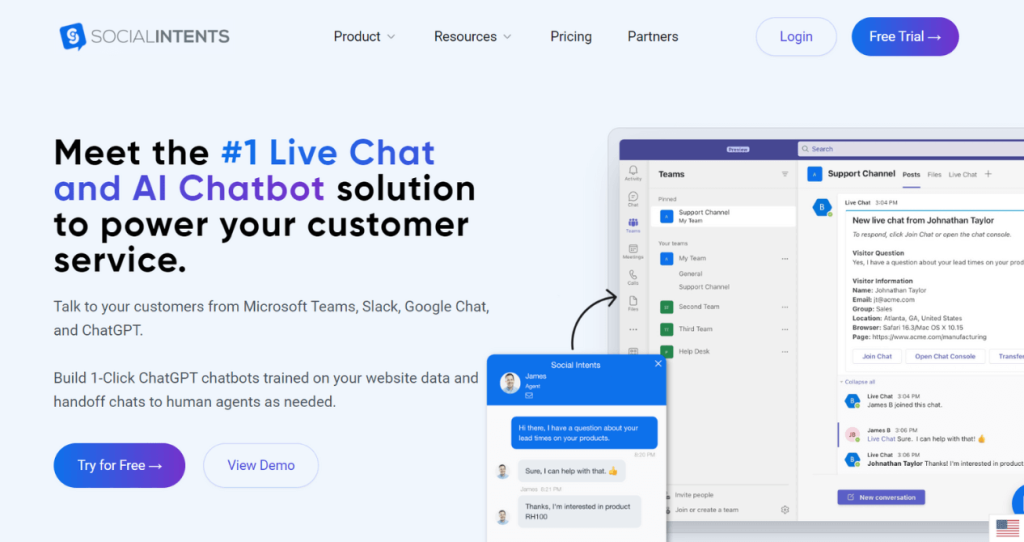
Live Chat
Social Intents make it super easy to set up a live chat without having to install software to implement it.
All you have to do is:
- Connect Social Intents to Slack or Microsoft Teams
- Embed the live chat code snippet on your web page
- Customize your live chat
In just three simple steps you’re all set!
Take a look at our step-by-step guide on how to add live chat to your website.

Chatbot
With Social Intents you can set up a ChatGPT powered chatbot to your website.
Implementing an AI chatbot means that you will significantly minimize common issues encountered with simple chatbots, including lack of personalization, query handling, and empathy. All thanks to its machine-learning capabilities.
You can set up our AI chatbot in five easy steps:
- Create your Live Chat app in Social Intents
- Connect your Live Chat to ChatGPT
- Add your OpenAI API Key to Social Intents
- Customize your AI Chatbot
- Copy your chatbot code snippet to your website
Don’t forget to read our step-by-step guide on how to set up an AI chatbot with no coding experience.
Live Chat vs Chatbot…Why Not Both?
If improving customer satisfaction is a key objective for your business, integrating chat support is crucial. Both live chat and chatbots are highly effective tools, proven to boost conversions and deepen customer engagement.
Live chat provides the human touch necessary for complex queries, ensuring personalized and empathetic interactions.
Chatbots, on the other hand, are ideal for handling high volumes of routine inquiries, allowing businesses to respond swiftly to customer needs.
Instead of choosing between a chatbot vs live chat, consider adopting a hybrid approach. This way you can optimize your customer service by assigning the right tasks to the right tools—chatbots for speed and scalability, and live chat for depth and personalization.
With Social Intents, you can quickly set up both a live chat and an AI chatbot—without the need for coding or extensive technical knowledge—making it easier than ever to optimize your customer engagement strategy.
Curious to see your customer satisfaction rates grow? Get started with our 14-day trial now.
